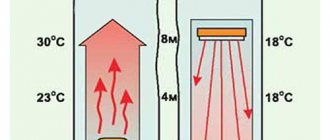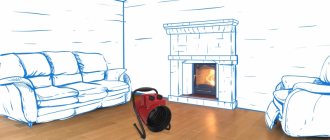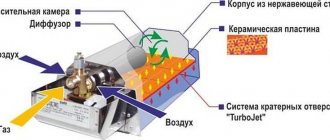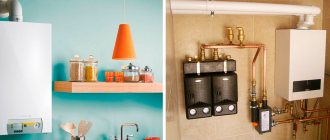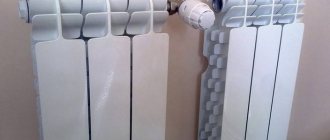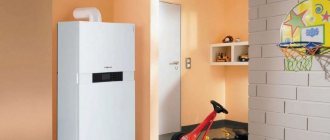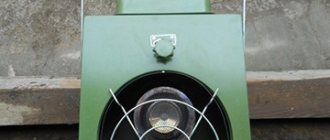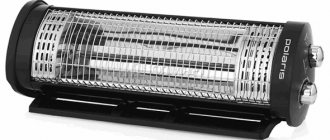Infrared radiation: nature and properties
Infrared radiation is included in the spectrum of electromagnetic radiation from the Sun. With the help of this part of the spectrum, heat is transferred directly to the earth, various objects and bodies, which in turn heat the air. It’s not for nothing that these rays are also called heat rays.
Solar radiation spectrum
But not only the Sun is a source of heat rays. As we have already said, any surface heated to a certain temperature emits infrared waves. The human body is no exception, the length of heat rays is approximately 10 microns (see Fig. 1). It is waves of this length that are the most favorable for humans; the human body perceives them as “its own.” Therefore, infrared rays have found successful use in therapeutic and preventive medicine. They help strengthen the immune system and contribute to the overall strengthening of all vital systems of the body. Under the influence of heat rays, blood circulation is stimulated, the supply of human body cells with necessary substances is improved, metabolism and regenerative processes are accelerated. This list can be continued for a very long time.
How do electric infrared panels work?
We found out that infrared rays are carriers of heat, which is so necessary for the normal functioning of the human body. Now let's figure out how such panels help provide heat to the entire house.
An electric infrared panel is a ceramic plate containing a resistive heating element. When current passes through such an element, it heats up and the heat is transferred to the ceramic plate. But why ceramics?
Ceramic infrared panels in the interior
Firstly, it has a high heat capacity. On the one hand, this is a minus, since it takes from 10 to 20 minutes for the surface of the stove to heat up to operating temperature. On the other hand, this is a big plus, because such material promotes uniform heating of the entire surface of the device and better distribution of rays in the room. In addition, after turning off the power, the surface cools down to room temperature within another 30-40 minutes (which cannot be said about water heating radiators or other heating devices).
Secondly, ceramics are a good choice for aesthetic reasons. We will talk about the variety of types of panels below, but for now we will only say that their range will allow you to choose the most suitable model for your interior.
In addition to thermal radiation, ceramic panels provide 30% heating by convection. This is achieved thanks to the presence of a radiator grille on the panel. This design allows you to install the device under a window to form a “thermal barrier” from cold air moving from the glass.
And so, we learned how infrared panels work, and that they provide uniform heating of the room with heat beneficial to the human body. What about the economic benefits of such heating?
Types of IR heating and heaters
Infrared emitters have several types of devices; installation is carried out on:
- Floor.
- Ceiling.
- Walls.
Heating of premises can be carried out in zones.
Ceiling heaters
Ceiling radiators are rarely used in apartments. They are suitable for outbuildings, office premises, street cafes. Craftsmen install panels into multi-level plasterboard structures.
Ceiling
Ceiling models of heaters are used in factories and at home. Industrial devices are more powerful than their household counterparts. The devices are often used in greenhouse buildings for early ripening of crops.
The heating device consists of a tube emitting waves and metal beam splitters.
Film infrared heaters
Film IR consists of a polymer film and carbon strips from which IR radiation emanates.
Film model
The film can be installed on any surface; folding the panel in half is not recommended.
The film can be placed on the ceiling, floor, or wall. To secure it, you need double-sided tape.
If fasteners such as brackets are used, you need to be careful and try not to get into the carbon strips. But if one or more strips are damaged, the IR emitter will continue to work.
Wall mounted thermal infrared panels
The use of models has begun recently. The device consists of several elements:
- The back wall is often metal.
- Heating element mounted on the rear panel.
- Ceramic front.
Some models are equipped with heat accumulators - elements necessary to collect thermal energy and gradually release it into the room. After a power outage, the storage device releases heat, preventing rapid cooling of the home.
Wall-mounted
The device includes a thermostat to regulate the indoor temperature.
Infrared heating using baseboards
The models are made of ceramics. Wide compared to regular skirting boards. The internal structure is similar to other types of IR emitters.
The panels are installed above the baseboard or instead of it. The device is suitable for hidden heating of a room. Minus - partial heating of the room, at floor level.
Warm baseboard
Gas infrared heaters
There are IR heaters that run on gas.
Principle of operation:
- Gas is being supplied. It mixes with air and is directed into the chamber.
- Under the influence of high pressure, the composition rises to the ceramic burner, where heating occurs.
The burner is equipped with small cells in which the gas is oxidized; the device heats up to 800°C. The heat is distributed throughout the living space.
Gas heater
The device is equipped with temperature regulators and sensors responsible for combustion safety. If the gas supply is turned off, fuel does not flow to the burner. There are devices equipped with elements that turn off the burner when the Gas IR emitter falls.
Recommendations for installation
To install infrared heating panels, you do not need special knowledge or experience. The tools needed for installation are at the disposal of every owner. The documents for the device must contain step-by-step installation instructions. If you haven’t found it, go to the panel manufacturer’s website, there is definitely such information there.
Fastenings for panels are already included with them. If you have your own vision on this matter, you can choose the fasteners yourself. However, be sure to make sure that it can support the weight of the panel you choose to install.
Here are a few more nuances that it is better to know about in advance, that is, before installation begins:
- A larger percentage of manufactured panels are ceiling panels. Many of them are equipped with corner brackets, but not all. Therefore, pay attention to this point when purchasing. Swivel models are better because their working surface can rotate 30°.
- For rooms with high ceilings, models are produced that are suspended on chains. This allows you to control the radiation intensity and select the heated area.
- To calculate how powerful the heating system should be to warm the room with IR panels, proceed from the calculation - 1 kW per 10 m2.
- Mount the panels at the recommended mounting height, as most lower wattage panels heat the room more efficiently and evenly by eliminating blind spots and hot spots.
During installation, do not allow the heating surface to come into contact with flammable or flammable substances.
Ceiling infrared devices are supplied with a complete mounting kit. The package includes brackets, hooks and chains depending on the model
Take care of high-quality insulation of electrical wiring contacts when installing the device. Use plastic caps or electrical tape for this.
Rules for installing IR panels
Installation of infrared heaters does not require special skills or the use of any additional equipment. All work can be performed even by a person far from repair and electrical work. The only exception would probably be ceiling panels. To install them, firstly, you will need a stepladder, and secondly, skills in handling Armstrong suspended ceilings.
So, first of all, you need to decide on the location of the heating device. As a rule, universal wall panels are installed in the coldest places, for example near balconies and under windows . The device is secured using the included fasteners and screws. Markings are applied to the wall, holes are drilled, into which dowels with brackets are then inserted. Then the heater itself is hung. After installation work, all that remains is to connect the device to the power supply.
With plinth panels the situation is somewhat different. They should be mounted at a level of 10 cm from the floor and 2 cm from the wall. They can also be connected to each other. Otherwise, installation does not differ from universal ones.
Infrared rugs do not require any kind of fastening at all. They are compact and mobile. You just need to put them in the right place, for example under your desk, and connect them to electricity.
The most difficult to install of all the models presented are ceiling infrared heating panels . Their main difference from other types is the absence of ribs and the power cable outlet is located at the back, not at the side. The panel is installed in place of the Armstrong ceiling cell and connected to electricity. If necessary, you can easily move the heater to another location by replacing the corresponding cell.
If you need to install not just one STEP panel, but several, or you need installation recommendations, you can use the installation service from our company. All work will be done as quickly as possible and in the best possible way. Moreover, our specialists will give you the necessary recommendations on the location of infrared heating panels for their greatest efficiency.
STEP infrared equipment is a new generation of efficient and economical heating devices. Take the opportunity to buy infrared panels in our store at an affordable price.
Most traditional home heating systems and space heaters use thermal energy to heat air, which also heats objects. However, infrared heating panels differ from them in that they are capable of converting electrical energy into heat. The heat from such panels resembles the heat coming from natural sources such as the sun, fire or fireplace, and this helps create a more comfortable atmosphere.
Arguments for and against IR panels
Those who plan to install infrared heating panels at home naturally want to know not only about their advantages, but also about the points that may cause inconvenience. Therefore, below is an objective assessment of both the positive aspects and disadvantages of this heating method.
The following arguments in favor can be given in favor of infrared panels:
- Impact resistance and increased strength. IR panels are not afraid of even shocks and falls. And all thanks to its shockproof body and heavy-duty materials.
- Easy installation and simple operation. You just need to fix the panel on the wall or ceiling and plug it into a power outlet. This does not require any special knowledge, a welding machine, etc.
- Low energy consumption. Firstly, there are no energy losses for heating the air. Secondly, IR radiation reduces the overall temperature of the space by 3-5 ºС, which allows saving energy up to 25%. That is, the air temperature is felt on average 5 degrees higher than the one shown by the thermometer when measured. And all because not only the air that is being measured heats up, but also the objects in the room and even the person himself.
- Quiet operation. Such heaters will not “crack” or “gurgle”, which means they will not interfere with sleep and other vital processes.
- Independence from power surges. Even if the voltage changes, this will not affect the operation of the heater.
- Maintaining normal air humidity. IR thermal panels do not dry out the air, like other electric convectors, which make breathing difficult and dry out the mucous membranes. They do not allow air mixing (cold/warm), so dust caused by heated air masses does not rise.
- Compact dimensions and lack of associated equipment. There is no need to install bulky pipelines, radiators, boilers.
Operating principle of IR panels
Advanced space heating technologies have made it possible to significantly reduce energy costs. IR panels are now recognized as an economical, reliable and independent way of creating a comfortable temperature in the house, independent of the general heating system.
If you are a supporter of progress, profitability, functionality and also an esthete, we suggest you pay attention to infrared heating panels. These economical devices have become a real breakthrough in the heating concept industry.
The principle of heat transfer of IR panels is similar to natural. The sun gives us not only light, but also warmth. Long-wave radiation heats the earth and everything on it, in turn, all objects give off heat into the air. This is on a global scale. In a local format - a step energy-saving panel - a miracle of physics, you can have at home.
Infrared radiation heats objects falling within the radiation spectrum, and heated objects, in turn, also give off heat into the air. A few hours after operation of the device, a comfortable temperature for a person is established in the room. Even after the panel is turned off, all objects in the room: furniture, walls, floors still give off the accumulated heat for a long time.
The design of the equipment consists of two elements:
- Emitter - which can be various types of lamps: carbon, halogen, quartz, as well as heating elements (aluminum plates).
- A reflector is a device that focuses rays in a given direction.
IR waves, depending on the power of the device, can penetrate and accumulate in the structure of various objects to a depth of 3-5 cm.
Important! Any heating device, due to the circulation of air masses, will not immediately provide a comfortable temperature in the room. But being in the spectrum of infrared waves, a person instantly feels warmth.
Being in the zone of infrared radiation, a person feels pleasant warmth, his body relaxes, as if under the influence of sunlight.
A few words about the types of infrared heaters
Conventionally, this type of climate control equipment is divided into three groups depending on the location: floor, wall and ceiling. The difference between all of them lies only in the installation pattern and the presence or absence of certain functions.
Floor
Instruments of this type of installation can be transported, which makes transporting it an attractive advantage when choosing a purchase. For ease of carrying, there is either a handle or a special compartment for installing a cord, and there may also be small wheels.
As a rule, such heaters have special sensors. For example, one of them saves you from overheating, the other turns off the device when it overturns. It’s interesting what thermostats or the ability to control from the remote control add.
Wall
This type of infrared heater has two places - a niche under a window or the bottom of a wall.
As a rule, they are made to look like central heating radiators, like many people already have in their house or apartment, but they are flat. Let us immediately note that they heat no worse than other types of IR heaters.
All wall-mounted options boast a thermostat and a system that protects the device from overheating. Since the wall-mounted model is heavier than the floor or hanging model, it is installed for a long time, taking into account all the nuances of the room design. During installation, you may need to decorate the device with various decorative elements, such as ornaments, stone, stucco, or simply paint it in the desired color.
Ceiling
Typically, ceiling options are made very similar to lamps, and they are quite bulky in size and quite heavy in weight. Such heaters are not entirely suitable for installation in residential premises - they are better used in non-residential premises, such as an office, garage, and various warehouses.
Variety of offers
Now let's see what the heating market offers us. Most often these are electrical appliances - oil radiators, heating panels, convectors, infrared heaters, fan heaters, ceramic panels. Not so long ago, stone radiators appeared - these are electrical devices that show excellent efficiency, all other things being equal.
Each type of heating device has its pros and cons, but today we’ll focus on Heat Stone panels - they represent a symbiosis of everything you need. Spectacular design, economical electricity consumption, durability and ease of maintenance - this is only at first glance. What's next?
Classification of infrared panels
Infrared panels come in two main types:
- mounted. Such panels most often have a colored metal body, which is heated by an infrared emitter. The device is connected via a socket and can be placed either separately or attached to the wall;
- built-in The base of such a panel consists of plasterboard, it contains two layers of emitter and insulation. At the top there is an IR emitter in the form of a carbon conductive thread, and on top of it is a protective polymer coating. The panel is connected to a 220 V network.
There are also designer wall panels, which are available in different sizes and colors. In addition, you can purchase a panel in the form of a plinth, which is attached around the perimeter of the premises instead of the usual one.
If you finish the walls with plasterboard, wall-mounted heating can be used as the main one. When you have another type of heating at home, for example, a source running on solid or liquid fuel, infrared panels can serve as a backup heating source.
However, along with the positive characteristics, this system also has its disadvantages , which are often mentioned in customer reviews:
- the heat from the rays is felt quickly, however, the effect of the infrared heater is too targeted. It will be very hot in one place and cold in another;
- if heat affects the human body unevenly, he will suffer from headaches and complain of constant fatigue;
- infrared stoves do not heat the air, but objects; sometimes this can cause a plastic smell to appear if they are directed at equipment;
- the power of the device is about 1200 W, but it can heat a room of up to 8 square meters;
- Waves of infrared rays can adversely affect vision.
Features of the use of film infrared heating
The main feature of film-type infrared heating is that it does not require heat transportation from its source, which sometimes causes heat loss. Also, the film can be placed anywhere : on the floor, on the wall or even on the ceiling.
Moreover, if the film is placed on the ceiling, it will occupy about two-thirds of its area, and this will allow the room to be heated more evenly. If desired, the film can be equipped with decor. However, never install an infrared heating source under suspended ceilings made of PVC materials or fabric.
First, a plasterboard frame should be placed above the film, and the decorative finish should not contain metal.
Such a system has the following advantages:
- the only necessary communication is electricity;
- no need to purchase boilers or have additional premises for installing the system;
- the system does not freeze;
- the ability to quickly reinstall everything in another location;
- no need for regular system maintenance, ease of use;
- absence of noise and combustion products;
- the system does not suffer from voltage surges;
- duration of operation (up to 20 years).
However, film infrared heating also has a significant drawback: it is quite energy-intensive and will require significant energy costs.
Other types of infrared heating
Ceiling-type infrared heating sources are quite economical and can be installed in rooms with a ceiling height of three meters or more.
In addition, they operate silently, can heat a certain area of the room, are environmentally friendly and convenient in terms of installation and subsequent operation. For suspended ceilings, some infrared heating manufacturers have provided special cassette-type heaters that are mounted in the ceiling.
However, along with high electricity consumption, infrared ceiling-mounted hanging heaters have another drawback, this time of an aesthetic nature: they are not always easily combined in terms of style with the overall interior design.
And wall-mounted infrared panels are a good alternative to traditional heating radiators. They are thin, can be of different sizes and are easy to install with your own hands.
Infrared heating panels
The infrared heating panel can be either wall-mounted or built-in:
- Mounted. Most often with a painted metal body, which is heated by an infrared emitter. They connect to sockets and can be placed either free-standing or attached to the walls, which is very convenient.
- Built-in. With a base of plasterboard, on which two layers of emitter and insulation are applied. On top of the sheet there is an IR emitter - a carbon electrically conductive thread, on top of which there is a protective polymer coating, which also performs a decorative function. Such panels are connected to a 220 V network.
Once again about the advantages of infrared panels, which reviews say:
- there is a thermostat that allows you to save energy and maintain the set mode;
- during heating, a minimum difference between the temperature of the ceiling and the floor is achieved;
- there are no pipes, no radiators, no heating boilers, and the panels themselves can be placed both on the walls and on the ceiling, the effect will be the same;
- on top of the panels you can put both tiles and gypsum cardboard, and simply cover them with wallpaper, thanks to the good heating temperature, reaching up to 50 degrees;
- quite a long shelf life, about 50 years;
- high fire safety;
- environmentally friendly.
When finishing walls with plasterboard, wall heating will be especially convenient and priority as the main heating system. If there is any other type of heating, for example, solid or liquid fuel, such panels can serve as an additional system or a backup one.
Of course, like any heating system, in addition to its advantages, there are also disadvantages:
- since infrared heating panels operate on electricity, which is not the cheapest now, this type of heating is a bit expensive;
- If you build heating panels into the wall, you will no longer be able to hammer nails into them and hang shelves or anything else.
Application of infrared panels
Heated thermal panels work well in a wide range of applications. Examples:
- heating of apartments, houses, holiday homes, winter gardens;
- heating of offices, conference rooms;
- heating of shops, service points, trading areas;
- heating of halls, warehouses, workshops, loading ramps;
- heating of exhibition and exhibition halls;
- communal heating;
- heating schools, kindergartens,
- heating of museums and galleries;
- heating of catering establishments;
- heating of hotels, sanatoriums, shelters;
- heating of hospitals and sanatoriums;
- heating of churches and places of worship;
- heating of sports halls, entertainment halls, sports halls;
- heating in zoological and botanical gardens;
- heating in livestock and crop production;
- heating in saunas, swimming pools and fitness clubs and much more.
How to choose the right IR panel
There are a number of parameters that must be taken into account when choosing electric heating systems:
- Room area;
- Ceiling height;
- Heat loss;
- Source type: main, additional.
The influence of IR radiation on humans
Since infrared devices can be called the latest miracle of technology, a natural question arises as to how safe the devices are for humans. Based on the results of scientific research, it was revealed that at moderate power, long-wave infrared radiation has a beneficial effect on the general condition of a person and does not harm the body. Moreover, medical institutions practice therapeutic procedures in specialized infrared boxes.
A negative impact from the device can only occur if the materials used to manufacture the equipment contain aggressive impurities that evaporate during operation of the unit.
Infrared heating systems are economical, mobile, do not take up usable space, and are safe for the health of people and animals.
Calculation of IR heating project
Only a specialist can make accurate and high-quality calculations when designing a heating system. But you can get approximate figures for infrared heating yourself. The following indicators are important in this matter:
- total power for heating the room as a whole;
- power density (its required amount per square meter)
- degree of comfort (temperature regime acceptable for residents).
Thermal insulation indicators must take part in the calculation. For non-professional calculations, you can rely on your own feelings.
Let's take a small cottage with an area of 200 m2, the owners of which feel comfortable at 190C. The house is built of sand-lime brick, double-glazed windows are installed. Heat loss in a home is average; a power density of 100 W/m2 is sufficient. The total power for heating it will be 2000W. It should be borne in mind that with an average value of heat loss, this value must be multiplied by a reduction factor of 0.85: with infrared heating, the temperature is felt 3-4 degrees higher.
The height and location of installation of the heating device is important. If the owners decided to place them on the wall at a height of 2.5 m from the floor, then it will be able to heat 8 square meters of area. In the ceiling installation option at a height of three meters, the volume of heated meters would increase to 24, which significantly reduces the number of heating devices in the project.
The level of heat and electricity costs depend on high-precision calculations, and it is best to entrust this work to specialists.
Recipe for an energy-saving heater: infrared panel + thermostat
Since infrared panels, like most electric heating equipment, are not capable of controlling the room temperature on their own, thermostats come to their aid. These devices, combined with temperature sensors, make it possible to constantly maintain comfortable conditions, optimizing energy consumption.
Thermostats come in different designs. The most common are devices with mechanical and digital controls (Fig. 4). Digital models, in turn, may have the ability to program an operating schedule, which will allow for maximum energy savings without sacrificing comfort. Programmable thermostats maintain a comfortable temperature only when it is actually necessary, and the rest of the time they provide economical heating.
Temperature regulators of the terneo brand for infrared panels: mechanical with installation in a socket box, digital with installation in a socket, digital with the ability to program a work schedule with installation in a socket
Thermostats also differ in installation method:
- for installation in a standard socket box with a diameter of 60 mm;
- for installation in a “Euro-socket” (Fig. 5);
- for mounting on a DIN rail in a distribution panel.
The last type is rarely used to control the operation of infrared panels, but the first two are ideal for working in a residential area. Several panels can be connected to one thermostat, based on the maximum power, thus ensuring comfort in a room up to 50 m².
Using an infrared panel together with a plug-in thermostat
The use of infrared panels, which we have already discussed above, together with terneo™ thermostats, allows you to save up to 30% of electricity compared to the conventional heating method.
Advantages and disadvantages of IR heating
Heating a home using infrared heating has excellent consumer properties:
- direct heating and its high speed. Directly transmits speed to surrounding objects immediately after connecting to the network;
- relative economy. Operates from a 220V socket, is equipped with a temperature sensor that transmits a signal to turn on when the temperature cools down and turn off after establishing a comfortable mode;
- the ability to heat individual local zones and open areas. An indispensable property for providing warmth to verandas and open terraces. Allows you to create warm areas in separate rooms (in the bedroom, in the nursery);
- service life. The simplicity of the design and operating principle preserves the vital functionality of the devices for a long time. In addition, IR heaters can be easily repaired;
- environmental friendliness and safety. The operation of IR equipment is free of noise, vibration, release of combustion products, oil vapors and other side effects inherent in traditional radiators. Does not burn oxygen and does not dry out the air;
- simplicity and flexibility of installation. Does not require highly qualified workers and great effort;
- possibility of remote control via smartphone, PC, remote control;
Negativity regarding infrared heating at home is in most cases far-fetched. Among the disadvantages are obvious:
- high cost of equipment (relative to other types of devices);
- rapid cooling of heating equipment. The oil radiator will continue to give off heat for some time after being turned off, and the IR equipment will cool down instantly.
- Direct dependence on electricity
A number of negative qualities are associated with erroneous power calculations during the design process and incorrect placement of devices. Negativity regarding IR equipment is in most cases far-fetched and is nothing more than a myth.
